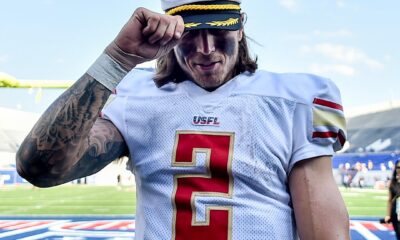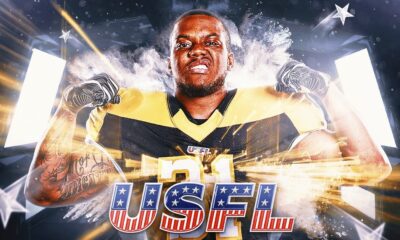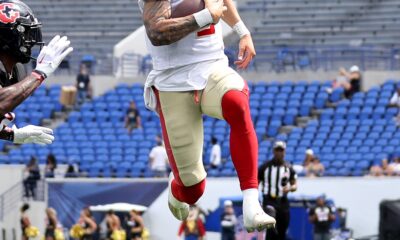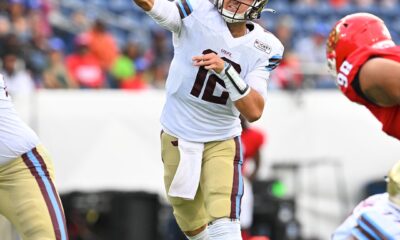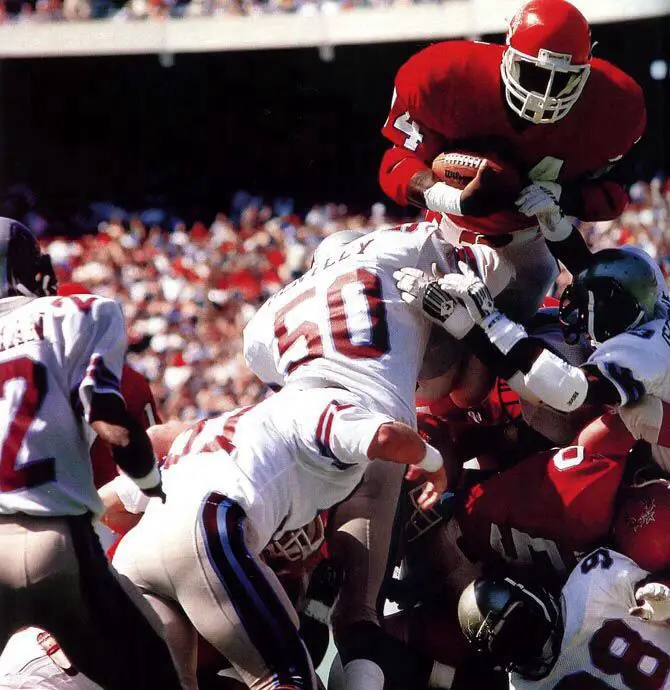
The USFL and the New Jersey Generals are back. But both the new league and team bare very little resemblance to the ghosts of their notorious past.
The 2022 USFL season is upon us. As someone who lived the experience of the USFL’s initial existence. Typing out that first sentence and imagining that reality seems surreal.
Spring Pro Football is back. And it’s returning under a very familiar name. The United States Football League, an entity that changed the pro football landscape four decades ago, has returned to reclaim its throne in the Spring.
The funny thing is that this newly minted version of the USFL, owned by FOX Sports, is publicly touting 2022 as its ‘inaugural’ season. The USFL, in name, might be returning to a space of the calendar it inhabited in the 80s, but the original league’s inaugural season took place in 1983.
Many of the fans who will be watching the USFL on FOX, NBC, and their other outlets, weren’t alive when the original league took the football world by storm. Some may not have even heard of the USFL if not for the incessant political discourse and narratives out in the ether over the years.
Before we look forward to the new league and season, let’s look back at the New Jersey Generals’ history.
New Jersey Generals’ Inception Into The USFL
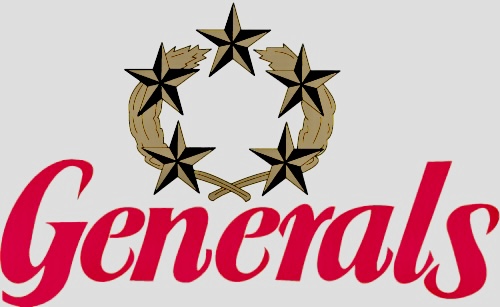
The most infamous franchise in USFL history. The New Jersey Generals. The big league team in the old USFL, backed by big money in the biggest market.
The New Jersey Generals were a franchise established in 1982 to begin play in the spring of 1983.
USFL founder David Dixon realized the importance of having a football team in the tri-state area. Initially, wanting a New York-named team before the league eventually settled on the New Jersey name as a condition for obtaining a lease to play games at Giants Stadium.
No matter what it took, getting a team in the top market was a top priority for Dixon in launching the league. And he wanted a big-time owner with deep pockets who could give the league cache but, more importantly, the financial wherewithal to make a splash. The USFL’s tri-state area team needed to be relevant. And wealthy businessman Donald Trump was tabbed as a preferred owner to accomplish those goals.
The only problem, which would help contribute to the league’s downfall later on, is that Donald Trump had grand designs of being an NFL owner instead. Trump made a play for the Baltimore Colts franchise and put an initial installment on the required franchise fee.
With Donald Trump temporarily out of the mix, David Dixon had to pivot and find another wealthy owner alternative for the Generals’. And he did so by roping in Oklahoma Oil Magnate J. Walter Duncan. The oil tycoon was supposed to head up his hometown Chicago franchise. But Duncan agreed to take over the tri-state area franchise instead. As the old saying goes, J.Walter Duncan took one for the team or, in this case, an entire league.
Plan B was in place. Duncan used his Oklahoma ties to lure in former Sooners coach Chuck Fairbanks as a minority partner. The also former New England Patriots head coach, Fairbanks, would assume duties as general manager and head coach. They named the team the Generals after the large number of generals based in New Jersey during the Revolutionary War. The logo, a gold five-star general wreath, was a tribute to the highest possible rank a military member in the Army could receive.
Herschel Walker
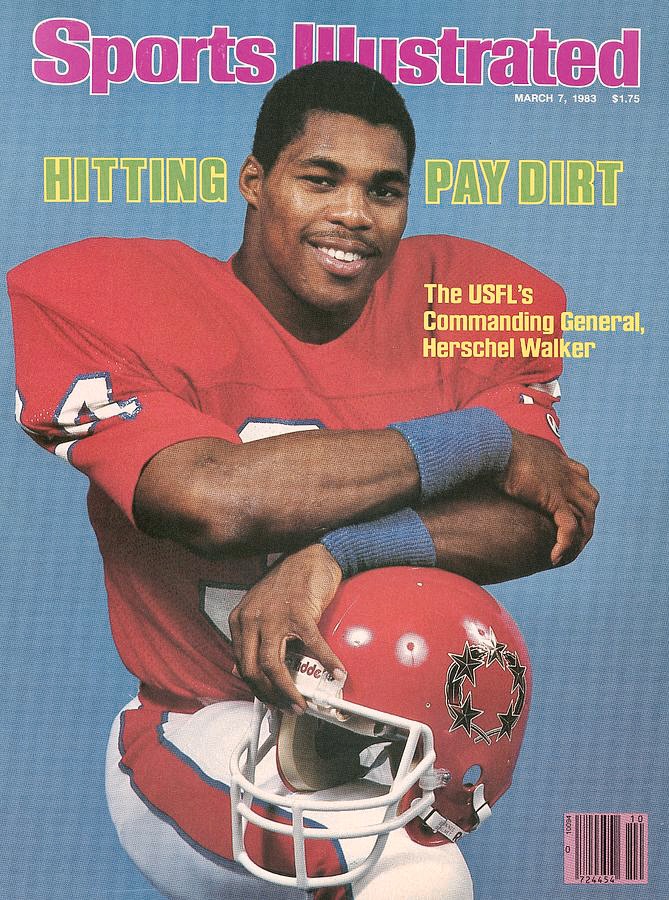
You can’t tell the story about football without having an entire chapter dedicated to Herschel Walker. His mere existence changed pro football forever, and he was also a game-changer on the field.
The entire football world would change and take notice the moment that the Generals signed one of the greatest collegiate running backs of all time, Heisman Trophy-winning underclassman Herschel Walker. The megastar at the University of Georgia, Walker, shocked the system by leaving school early to sign a “personal services” three-year contract valued at $4.2 million.
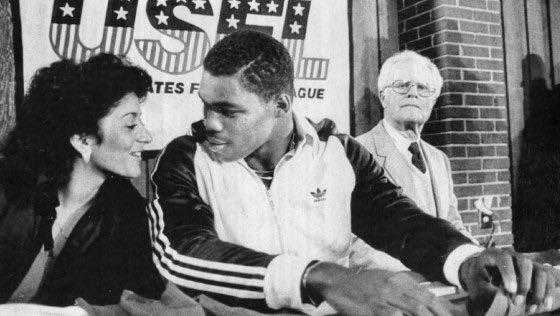
Initially, the USFL didn’t intend to break the underclassmen’s rule. The plan was to follow the NFL’s lead. But obtaining a player of Walker’s caliber was too tempting to pass up. The NFL tried to challenge Walker’s jump to the USFL in the courts, but ultimately that attempt failed.
It was also not the intention or part of the USFL’s plan to exceed their initial salary cap set at $1.8 million. Nonetheless, the USFL was willing to pay the price of giving their league instant credibility and notoriety by going after college superstars. That’s what the signing of Walker and eventually others accomplished.
Herschel Walker’s deal was a hefty price for the upstart league. And would open the floodgates for other high-priced college players like Hall Of Fame quarterback Jim Kelly to follow suit and buck the system and bypass the NFL for a new pro league.
Herschel Walker is one of the more notorious figures in football history. Not just for the precedent he set at the time for college football athletes but also for the changes in salaries for pro football players, who were paid modestly at the time, and ultimately because of a trade later on in the NFL that built the Dallas Cowboys dynasty in the 90s.
Lost in all that sauce, so to speak, is that the USFL version of Herschel Walker was a game-changer on the field. Over the years, his early exploits on the field as a young running back have taken a back seat in his narrative. But as a 21-year old rookie back in 1983, Herschel Walker was a dominant force right out the gate. In his first year as a pro for New Jersey, Walker amassed 2,301 yards, nabbed 53 receptions, and scored 18 touchdowns.
Herschel Walker was a tackle-breaking machine in the USFL who was a threat to score on every play. In his three years playing in the league, he had multiple scores over 60 yards and two scoring plays of 80 yards for more.
Walker was an absolute workhorse for New Jersey. He carried the team and ball 1,143 times for 5,562 yards in three seasons, and Herschel also added 130 receptions for 1,484 yards. In total, Walker scored 61 touchdowns in the USFL.
Herschel Walker’s 1985 performance still stands up as one of the greatest single-season performances by a pro football player in history. Walker was named USFL MVP after setting the pro record in a single-season rushing for 2,411 yards on 438 carries. For added measure, Walker registered 467 yards receiving on 37 receptions. He scored a staggering 22 touchdowns, 21 of them on the ground.
The truth is that while Herschel Walker ended up having a good post USFL career in the NFL, playing 13 seasons, as a multiple-time pro bowl selection, with over 13,000 career yards and scoring 82 touchdowns. Walker’s greatest years came before he traded in his five-star helmet in New Jersey for the lone star one in Dallas.
At 60 years of age, Walker, still in phenomenal shape today, probably still has a few snaps left in his body. But there’s no denying that the wear and tear of his peak years in the USFL diminished some of his shine for the rest of his pro career.
Arguably, Herschel Walker, in his early prime, was pound for pound one of the greatest running backs ever. In a league like the USFL, which was loaded with future hall of fame players like Reggie White, Jim Kelly, Steve Young, Sam Mills, and others. Walker stood right with them on a very high pedestal. He was not only the New Jersey Generals’ best player, but he might’ve been the best player that played in the USFL.
New Jersey Generals History
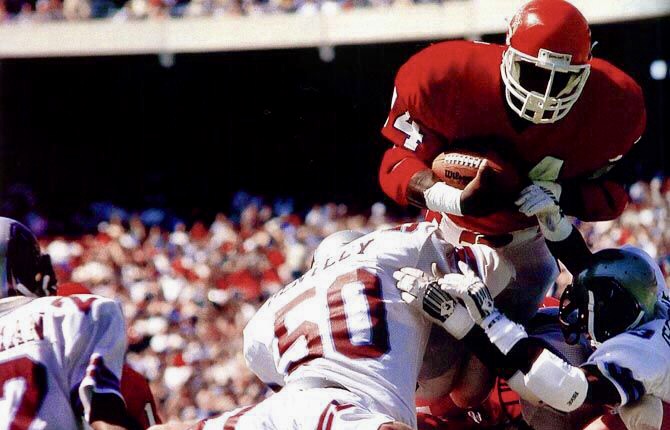
The New Jersey Generals almost lived up to their massive hype on the field. The team never got to the mountain top because there were various obstacles in their way. But they came close.
In year one of the franchise, despite rookie Herschel Walker’s standout performance. The team fell way short of expectations, only winning six games. The Generals were third in the league in attendance, drawing over 35,000 fans per game. But the original Generals owner J. Walter Duncan wanted out. The northeast was too far away from his neck of the woods in Oklahoma. And the burdens of carrying the league’s signature franchise were too much for him. So he sold the team to Donald Trump, who was back in play with the USFL after his Baltimore bid in the NFL fell through. More on that later.
With new ownership in place, HC/GM Chuck Fairbanks was out after a dismal 1983 season. New Jersey eventually landed on former New York Jets head coach Walt Michaels as its new leader. Under Michaels, the Jets had reached the AFC Championship game in 1982 in the infamous Mud Bowl. But just 17 days after that game, depending on what version of the story you want to believe. Michaels resigned his post to tend to personal matters.
Walt Michaels did a phenomenal job turning around the Generals’ in the same city where he patrolled the sidelines for the Jets. The talent on New Jersey’s team improved greatly in 1984, thanks to an aggressive run in free agency by new ownership. But Michaels was largely responsible for the turnaround; he brought a steady hand and improved the team’s fortunes.
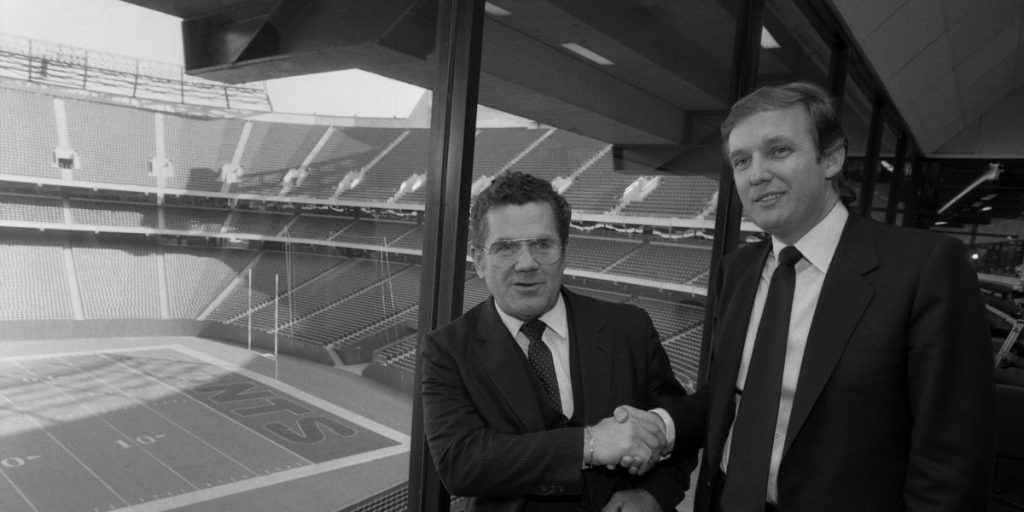
The year before his arrival, the Generals’ defense gave up the third-most points in the league. A longtime defensive coach and coordinator, Michaels resurrected the Generals’ defense immediately. And made them one of the better units in the league.
However, the biggest Achilles heel for New Jersey before Walt Michaels came on board in 1984 was at quarterback. Ex-New Orleans Saints QB Bobby Scott, who infamously was the backup to Archie Manning for several years, didn’t fare well captaining the Generals offense in 1983.
Because of New Jersey’s feeble passing results in year one, the Generals went hard after 1980 NFL MVP and Cleveland Browns starting quarterback Brian Sipe. New Jersey signed him away with a three-year deal worth $600,000. That sum doesn’t read like much today but considering that the average NFL salary in 1983 was 130,000, Sipe received a significant pay increase to play in the USFL.
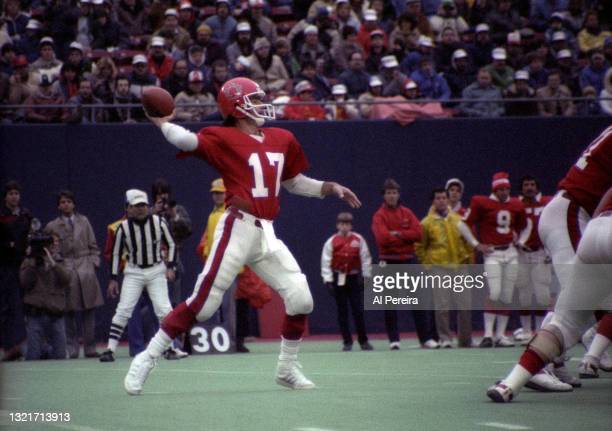
Brian Sipe helped stabilize and bring balance to the Generals’ offense in 1984. Sipe’s numbers were far from off the charts, 2,540 and 17 touchdowns with a 59.1 completion percentage. But Sipe provided a strong veteran presence in the locker room and on the field.
A year later, the Generals attempted to go from solid to spectacular at quarterback when they drafted in the territorial draft and then eventually signed Boston College’s Doug Flutie to a groundbreaking, at the time, a five-year deal worth $7 million. Flutie had his fair share of doubters because of his size. At about 5’10 and 175lbs, there were legitimate concerns about Flutie’s ability to make it in the pro game.
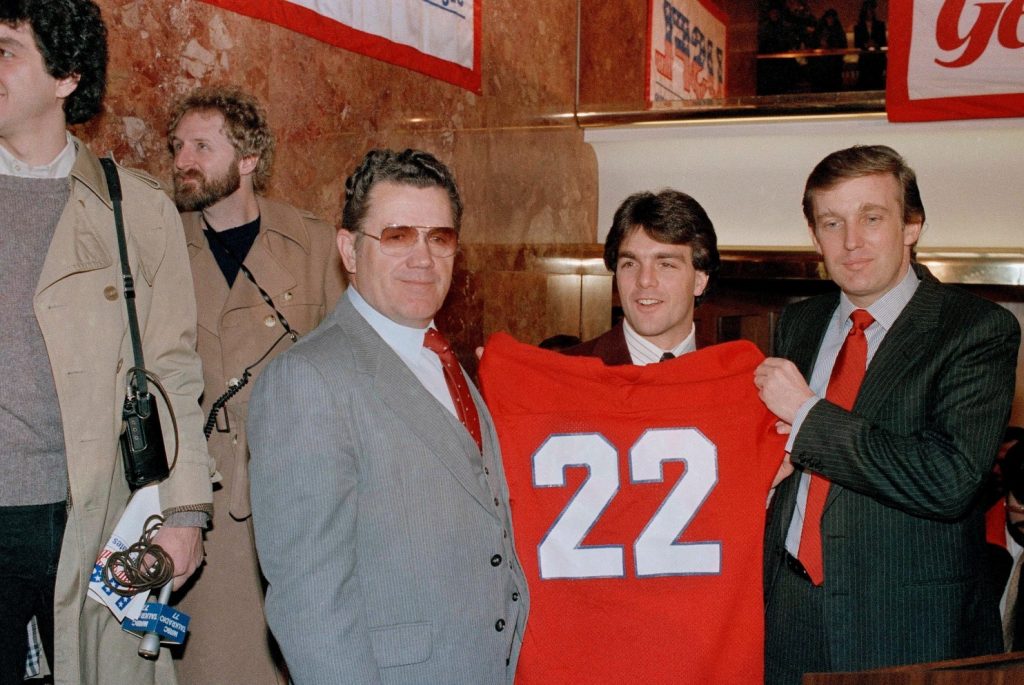
The cult favorite and ultimate underdog hero, Doug Flutie, did bring a lot more attention to the league and Generals’. New Jersey’s average attendance rose for the third year in a row to over 41,000 fans per game. However, unfortunately, Flutie’s performance, particularly as a passer, was below average. He completed less than fifty percent of his passes and threw for more interceptions (14) than touchdowns (13).
Despite the rookie Flutie’s struggles throwing the football, he was still an exciting player to watch. Flutie displayed his dynamic running ability on the ground, rushing for six touchdowns and 465 yards. Flutie’s frantic style in the pocket was entertaining.
A broken collarbone late in 1985 would put an end to Fluties’s up and down rookie season. And as a result, he was unable to silence his doubters. That would come later in Canada with the CFL, where Flutie became a legend, and in the NFL in the twilight of his career when he achieved pro bowl status with the Buffalo Bills.
The New Jersey Generals went for it all in the USFL but fell short. For three years, the team was very exciting. They made big-league moves, perhaps one too many; more on that later. But it was a fun ride while it lasted.
Record wise, over three seasons; the New Jersey Generals were 31-23. After going 6-12 in 1983, the team made the playoffs twice in back-to-back years. In 1984, New Jersey was 14-4 but lost in the divisional round of the playoffs to the eventual USFL champion Philadelphia Stars.
The Generals went 11-7 in the regular season a year later. But once again, they were one and done in the playoffs when their arch-nemesis, the now Baltimore Stars, eliminated them from playoff contention. That was the Generals’ final game.
The Downfall Of The USFL
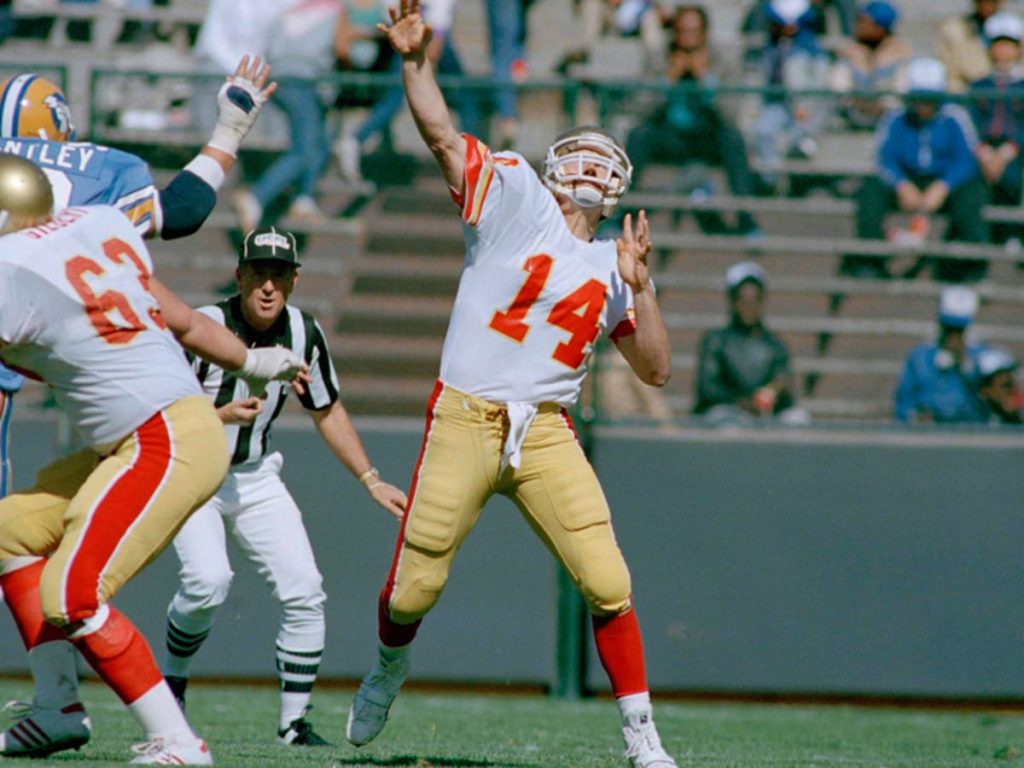
For those looking for one of the reasons why the USFL ended up in a situation where they attempted a last-ditch effort lawsuit against the NFL to save the league from extinction. Look no further than what happened to the franchise that prevented the Generals from winning it all twice, the Stars.
Because the league had desires of moving into the fall and because the league had multiple failing franchises with shoddy ownership and attendance. Successful USFL teams like the Stars, who went to three straight championships, were put in the position of biting the bullet and moving to Baltimore.
The USFL was falling apart at the seams. They expanded from 12 to 18 teams in year two. Multiple franchises were struggling financially. Many of the league’s owners failed to hold up their end of the bargain. Like players on an injury report, paychecks from the owners were questionable and doubtful every week. That’s how bad it got.
USFL teams like the Breakers moved twice and played in three different cities in consecutive years. They weren’t the only ones. Franchises were merging or being swapped to consolidate financial losses. And by year three, the USFL was contracted back down to 14 teams. The USFL had become a league of the have lots, and the have nots. While Tampa, Jacksonville, and New Jersey were thriving at the gate. Many of the other franchises were either dying or barely surviving.
ABC Sports, the league’s broadcast partner, was so embarrassed at the dwindling attendance around the league in 1985 that they told the USFL that it didn’t want to televise games in near-empty stadiums. It almost came to a head in the 1985 playoffs, had the Stars obtained home-field advantage by winning the Eastern Conference.
Because of their contract with the USFL, ABC’s control would have forced Baltimore to play on the road had they won the East because of their sagging audience. A once-proud franchise and the royalty of the USFL, the Stars came close to suffering an insulting fate because they struggled to draw fans.
The where did it all go wrong for the USFL question usually has one answer.
Donald Trump
The elephant is in the room, and I might as well acknowledge it.
The man who received the second-most votes ever in a presidential election, 75 million in 2020, has always had a way of swaying people over to his side of the fence. That’s exactly what happened in the old USFL.
Donald Trump made several huge power plays when he was in the football world. The last one was a hail mary attempt, one that he spearheaded by coercing a bunch of desperate owners looking for salvation from someone who, rightly or not wrongly, appointed him as the league’s savior. Some would argue that Trump did that himself. But he wasn’t the only person in power in the USFL. He was just one man. Others had to follow, and they did.
Back in 1985, if you had told me as a young kid that Donald Trump, a then Democrat, would become president of the United States one day. I would have laughed at you. In the same way, Doc Brown laughed at Marty McFly in Back to The Future when he told him in 1955 that actor Ronald Reagan would be president thirty years later.
From day one, Donald Trump’s motivations with the USFL were questioned. Was he really investing his finances to help the league be great? Or was it all about ulterior motives and getting what he ultimately wanted? Many people would answer the latter.
There are several alternate narratives that all point to Donald Trump as the reason for the USFL’s demise. The first is that he ultimately wanted an NFL franchise. Something that he tried before joining the USFL and again many years later when he attempted to buy the Buffalo Bills. The second narrative is that Trump had a vendetta and wanted to take down the NFL. The third narrative is that Trump wanted to force the NFL to merge with the USFL. Perhaps it’s all of the above.
One thing is clear-cut when looking at this situation, it’s quite a feat for one owner to convince every owner and person in a position of power in a league to follow his lead.
Before Donald Trump bought the New Jersey Generals from J. Walter Duncan, the USFL had already ruffled the feathers of the NFL and declared war. By upsetting the apple cart, disrupting the draft system, and going after the NFL’s best players. I would argue that it ended up for the betterment of the entire football landscape for players and coaches. But the line in the sand was already drawn by USFL leadership before Donald Trump ever joined the league as a single owner.
The NFL, a league that, in its early days, said that they would never air their games on multiple networks out of competitive fairness. Did precisely that over time. The USFL, in their eyes and minds, was cutting into their action. The United States Football League was the last entity that was ever truly a threat to the National Football League. And make no mistake, as hard as it is to fathom, considering the kingdom that the NFL reigns supremely in 2022. The USFL was a legit threat to the NFL’s throne.
Moving to the fall was absolutely part of the USFL’s demise. The facts are that Donald Trump pushed that power play. And everyone else came along for the last ride. Trump, who has always had an inflated go, legitimately thought that the USFL could beat the NFL in court, and they did. But the fools’ gold came in the form of one dollar.
One could argue that the USFL was headed towards a demise eventually. Despite the fluffy narratives depicting the USFL as a healthy league. The USFL wasn’t in good standing when they made their push against the NFL in the courts. The USFL won its anti-trust lawsuit against the NFL. But it was the equivalent of winning one hand of blackjack at a casino. You don’t get to take over the whole operation if you do; ultimately, the house always wins.
Setting aside the issue of what or who caused the USFL’s demise. There’s no doubt that it’s challenging to label Donald Trump as a good owner when he is widely associated with singlehandedly destroying the league. But the New Jersey Generals were a pretty good team under Donald Trump, and they won a lot of games in his two seasons as owner and were third in the league in attendance.
Donald Trump was an aggressive owner. He tried hiring coaches like Don Shula, Joe Paterno, and Joe Gibbs. At the time of the league’s end. There were also reports that the Generals had a contract waiting for Lawrence Taylor when his New York Giants contract expired. The Generals left no stones unturned. Whether it was for his own personal ego or not, Trump tried to win for better or for worse.
And Donald Trump’s plans for 1986 were quite fascinating. After the 1985 season, Trump had already made a deal to merge with Stephen Ross’s Houston Gamblers. The merger would have seen a “Dream Team” scenario with Jim Kelly at quarterback, Ricky Sanders at wide receiver, and Herschel Walker at running back.
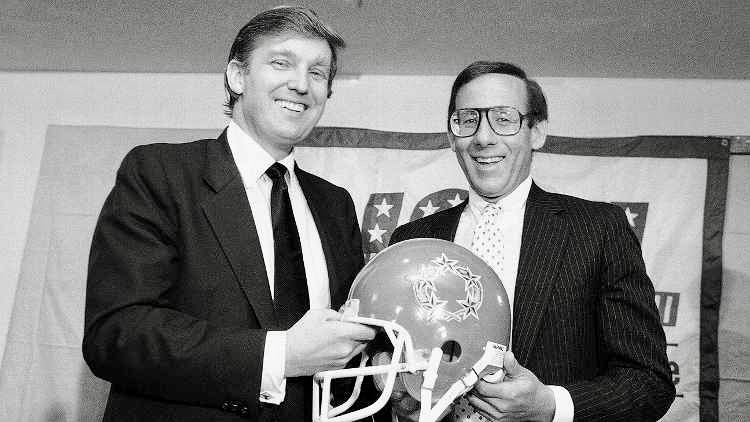
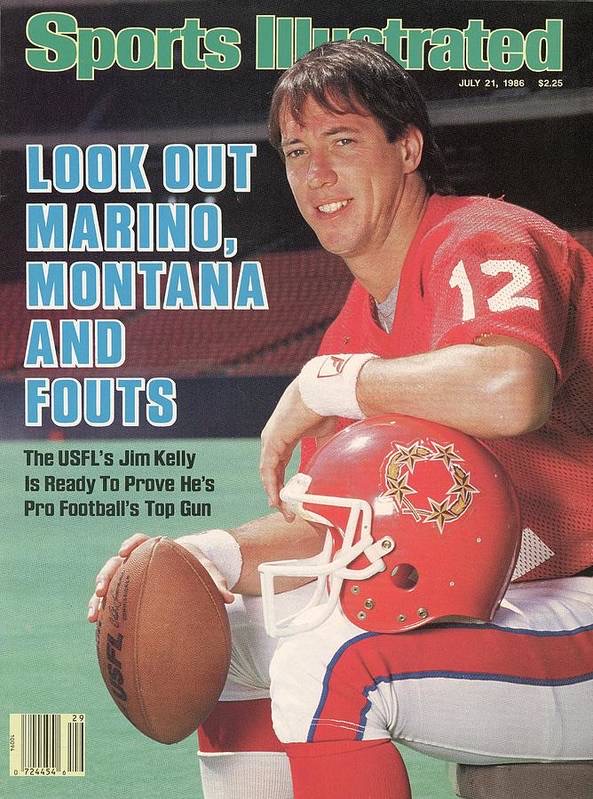
Trump had also planned to move the Generals across the Hudson River to New York. The idea was to be the only football team in New York City. After the Jets had moved in 1983 from Shea Stadium in Queens to the Meadowlands in New Jersey, the newly christened New York Generals would have played at Shea until the construction of a new stadium in Manhattan.
Of course, none of these things came to fruition. It’s all ancient history now. The USFL and the New Jersey Generals chapter may have been closed nearly four decades ago. But the stories continue to be told and re-told.
The New Jersey Generals have new life in the USFL of 2022. Something tells me that no matter what happens with this new version, they will never be able to replicate what the original one did. Perhaps that’s a good thing.






